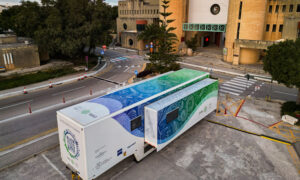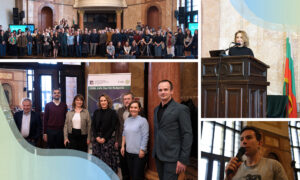
BIOcean5D targets marine biodiversity
EMBL hosts inaugural meeting for major interdisciplinary project designed to boost understanding of ocean life

Researchers from across Europe gathered at EMBL Heidelberg to begin work on a large-scale project exploring life beneath the waves, in all its forms. BIOcean5D brings together 31 research partners with the aim of holistically exploring marine biodiversity at molecular and organismal levels – from viruses to mammals – across space, time, and human scales.
Painting a multiscale picture
This major undertaking spans national borders and scientific disciplines, and will be rolled out over the next four years. It will provide a vital insight into the rapidly changing nature of marine ecosystems.
The project is centred around the essential role that biodiversity plays in sustaining marine ecosystems. Such ecosystems are vital for planetary and human health, and yet large gaps in scientific knowledge and understanding remain. Recent surveys of marine ecosystems have revealed a lack of understanding about the abundance, function, and collective dynamics of marine biota, as well as presenting environments that are changing at an exceptionally fast rate as a result of human activities.
Collaborative working
This meeting provided the first opportunity for participants to come together as a group. Through a series of presentations, breakout sessions, and networking opportunities, participants planned the operational details, including for example how data from different sampling sites is collected, analysed, and shared.
“The project encompasses many different disciplines, and that means it is vital that people from different scientific backgrounds are able to come together and make sure they are all speaking the same language,” explained Peer Bork, co-leader of the Data-to-Knowledge work-package, and Director of EMBL Heidelberg.
“With such an ambitious work plan, it’s vital that there is a regular dialogue between all the different partners and aspects of the project. EMBL is the project coordinator, headed by Director General Edith Heard and working together with the Planetary Biology team. We are all very committed to the successful launch of this project, and to making the most of this fantastic scientific opportunity,” explained Josipa Bilic Zimmermann, EMBL’s Planetary Biology programme manager and acting BIOcean5D project manager, who organised the kick-off meeting.
Several sessions focused on the importance of agreed processes and standards on approaches to sampling and data systems, given the vast quantities of material that will be generated. BIOcean5D will create a digital foundation of multiscale biodiversity data and knowledge, and develop tools for monitoring, predicting, and protecting marine biodiversity and the essential role it plays. Such efforts will play a vital role in improving the existing, highly fragmented view of marine biology.
Other sessions discussed the novel technologies that aspects of the project will utilise – including the so-called ‘frugal science’ movement as employed by the Plankton Planet initiative – and the great potential that has been opened up in recent years thanks to the improvements and reduced costs of environmental DNA sequencing.
Ultimately, BIOcean5D aims to paint a holistic picture of pan-European marine coastal biodiversity and ecosystem services, and will take a range of approaches including the use of mobile labs, research vessels – including the Tara schooner – and ‘seatizen science’ tools.
Marking a new ecological era
Colomban de Vargas is Research Director at CNRS/Sorbonne Université, and the BIOcean5D project deputy director and scientific project coordinator. He explained what sets this enterprise apart from other research programmes, “BIOcean5D is all about marine biodiversity. One of our important novelties, and strengths, is combining the MICRO- and MACRO- biomes, and in this way covering the full organismal and functional biodiversity, which is arguably the biggest challenge of modern ecology.”
“By doing this across space, time and human impact (the 5 Dimensions of BIOcean5D) I believe we will be marking a new era in ecology. The beauty of BIOcean5D is also the large space left for fundamental research, exploration and discovery. We are about to re-explore marine life, from viruses to whales, in water, sediments, and aerosols, along the entire European seascape from Finland to Crete (in collaboration with the TREC expedition).”
He added, “We will do this with new methods allowing deep quantification of genomic and morphological biodiversity at both population and individual levels, including the microbiomes living in symbiosis with larger biota.”
Over the coming four years, BIOcean5D will help to bridge molecular/subcellular biology to organismal biology, theoretical ecology and econometrics, and marine complex systems to social sciences. These efforts will ultimately feed into the urgent tasks of informing international policies to underpin the sustainable preservation of our oceans and seas.
Commenting on the ambitious nature of the project, Josipa Bilic Zimmerman said, “We are at the beginning of a long, exciting road with this project, and this is clearly the onset of something bigger. Together with the great potential offered by the development of new technologies, we are able to come together under the BIOcean5D consortium, and combine expertise in molecular biology, ecology, oceanography, data sciences, economy and ocean literacy. Through this great collaboration – that will provide us with valuable data and a more detailed insight — we can make an important contribution to a future of sustainable preservation of our oceans and seas, and all the life they support.”
BIOcean5D has received more than 17 million Euros in total from the European Commission under grant agreement 101059915, and from the Swiss and UK government for Swiss and UK partners.


